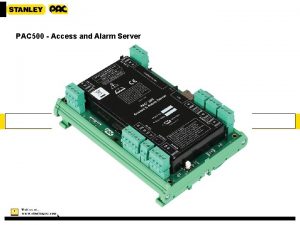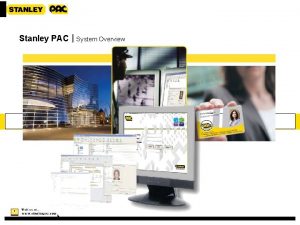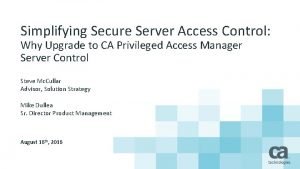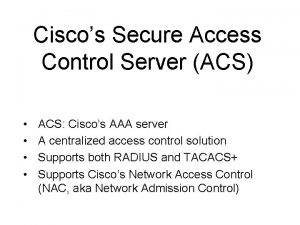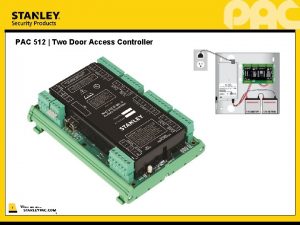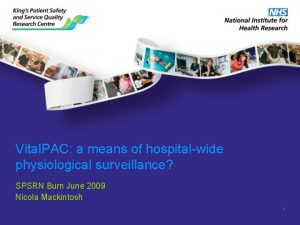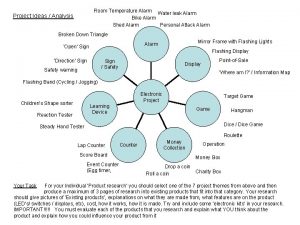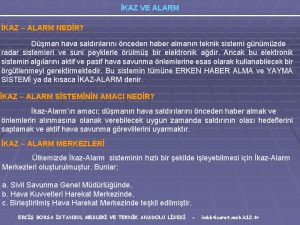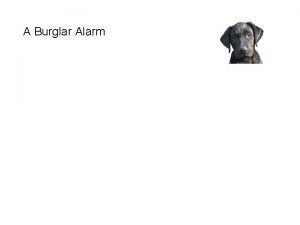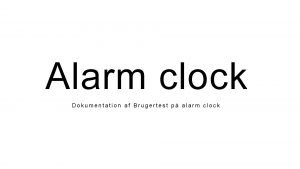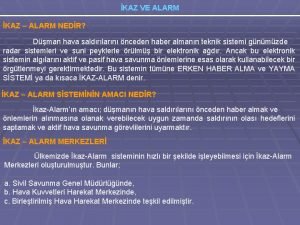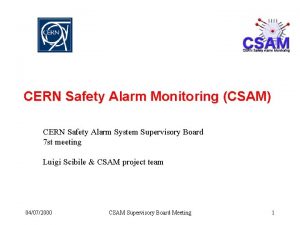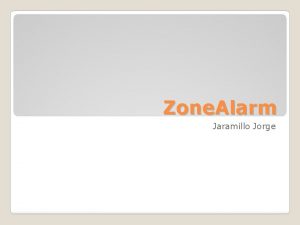PAC 500 Access and Alarm Server 1 Access
























- Slides: 24

PAC 500 - Access and Alarm Server 1

Access and Alarm Server | Overview Powerful, expandable and intelligent access control server Easily configured and integrated into any corporate LAN/WAN infrastructure – managed by embedded Microsoft Windows CE. Net and powered by a powerful Intel Xscale processor. Communications are secured using Secured Socket Layers (SSL) and a built-in Firewall Capable of managing multiple locations it can locally administer the access control for any sized enterprise and process all access transactions locally, independent of a host system The PAC 500 is required in order to coordinate a wide variety of alarm, monitoring devices and elevators and can manage up to 48 controllers and 75, 000 cardholders 2 2

Access and Alarm Server | Features The Access and Alarm Server (PAC 500) includes the following key functionality: Access control management Management of controller modules, including door, input and output controllers Alarm Management Embedded Microsoft CE. Net operating system Event management Event recording Event messaging and reporting (to host system) Area Anti-Passback and Area Usage 3 3

Access and Alarm Server | Features (Continued) The Access and Alarm Server provides the following advanced design features: Multi-tasking, microprocessor based platform Embedded Microsoft Windows CE. Net architecture Powerful Intel Xscale processor with low power consumption 100 Mbps Ethernet communications with host system using TCP/IP Secure Sockets Layer (SSL) encryption for communications between the host system and the PAC 500 Built-in Firewall 2 x RS-485 communications channels One-Touch™ installation testing 4 4

Access and Alarm Server | Features (Continued) The PAC 500 also provides the following advanced features: 64 MB onboard RAM 32 MB of FLASH Memory Status LEDs to confirm operation Supports a maximum of 96 doors per PAC 500 Support for up to 75, 000 cardholders, the PAC 500 dynamically ‘pushes’ cardholder data downstream to Access Controllers (PAC 512 s) as requested RS-232 for dial-up modem Override and tamper inputs Stores up to 100, 000 events (with 20, 000 cardholders) Battery backed, real-time clock Distributed intelligence providing the ability to work offline Flash memory for remote firmware updates 5 5

Access and Alarm Server | RS-485 Communications Channels The PAC 500 provides 2 communications channels to 48 devices. Channels are used to communicate with and manage controllers like the PAC 512 Two-Door Access Controller or PAC 530 Output Controller. These channels provide the following features: Up to 24 controllers (PAC 512, PAC 520 or PAC 530) can connect to each RS-485 channel RS-485 communications Secure encoded communications Status LEDs for each port 6 6

Access and Alarm Server | Secure IP Communications The PAC 500 communicates with Stanley PAC administration software via an embedded 100 Mb Ethernet connection over any WAN or LAN where devices on the network can be assigned a unique IP address. All communications routed through this connection are fully encrypted using Secure Sockets Layer (SSL) and the PAC 500 sits behind its own built-in firewall. In addition, the PAC 500 also encodes communications with the controllers it manages over RS-485, to ensure that all data transmitted within the access control network is secure. 7 7

Access and Alarm Server | Controller Architecture The Access and Alarm Server (PAC 500) uses encrypted SSL communication with the Host system, via an on-board 10/100 Mb Ethernet port or dial-up modem. The dual RS-485 bus enables combinations of up to 48 local devices (PAC 500 Series Controllers) including: • Two-Door Controllers (PAC 512) • Input Controllers (PAC 520) • Output Controllers (PAC 530) 8 8

Access and Alarm Server | Elevator Control The Access and Alarm Server (PAC 500) provides Elevator Control. Card readers may be installed in elevator cars to provide restricted access to floors. Typically each elevator car requires one card reader and one relay output for each floor select button. If reporting is required on cardholder destination, then one input is required for each floor select button in the elevator car. 9 9

Access and Alarm Server | Distributed Intelligence System downtime is costly, particularly in a highly secure environment. The PAC 500 overcomes this potential risk through the use of its Distributed Intelligent Controllers. Even when the main communication lines are lost, the security at your facility can still be maintained. Both Access and Alarm and Servers (PAC 500) and Access Controllers (PAC 512 Series) can operate independently of the Stanley PAC Administration Software. All events are date and time stamped before being sent to the PAC 500 by the PAC 512 and each is capable of buffering events should communications fail. PAC 512 16, 000 Event Buffer PAC 500 The ratio of cardholder records to events can be adjusted, for example it can buffers up to 100, 000 Events with 20, 000 cardholders The PAC 500 can utilize ‘Fallback communications’ via a dialup modem 10 1

Access and Alarm Server | Platform Architecture The technology used in the PAC 500 was developed from the ground up using Microsoft’s innovative. NET platform, Windows CE. NET and built around n-tier development. This single platform offers a combination of an advanced, real-time operating system with the most powerful tools for rapidly creating the next generation of smart and connected access control devices, like the Access and Alarm Server (PAC 500). The. Net platform’s innovative design scales from the smallest devices to the largest of enterprise configurations, and enables code to be written once and reused across multiple components of the Stanley PAC access control product line. 11 1

Access and Alarm Server | One-Touch™ Installation Mode To speed up trouble shooting and ensure error-free installation, One-Touch™ mode enables the controller functionality to be tested at the controller by just pressing a single button. There are two test modes: Active Mode Used during system configuration to enable a walk test by a single person. This is achieved by use of latching LED status which indicate the first change in input condition. View Mode Used on a configured system to check the condition of inputs by using on-board LEDs. The LED display indicates changes of input state, so alarm and tamper circuits may be walk tested with one person to perform the walk test and the second to monitoring LED changes. One-Touch™ Button 12 1

Access and Alarm Server | Port Layout 13 1

Access and Alarm Server | Door Override Input - Normal The Access and Alarm Server (PAC 500) has an input for door override. An override condition will release the locks on both door channels on all the connected PAC 512 Access Controllers. 14 1

Access and Alarm Server | Door Override Input - Supervised The Override Input can be monitored with four-state supervision to minimize the occurrence of false alarms. Both short-circuits and open-circuits on the cable can be detected and reported 15 1 Normal 2. 2 k Active 6. 9 k Tamper ∞k Short 0 k

Access and Alarm Server | Area Anti-Passback (APB) ensures a cardholder credential can only be used to enter an area once. This prevents cardholders "passing back" their card to others to provide access to the site and will not open the door for anyone else using the same card. Information that the cardholder is already on site is shared with all other controllers, thereby rendering the card ineffective to an unauthorized person at any door. Operator can reset the APB of an individual cardholder after a passback violation has been forgiven. Passback violations can be reset at specified times (e. g. Overnight) Configurable time period for each APB areas may reside within other APB areas 16 1

Access and Alarm Server | Tamper/ Door Override Inputs The Access and Alarm Server (PAC 500) has an input for tamper detection and door override. The Tamper input triggers a system alarm event if an unauthorized access to the cabinet door is detected. When the Door Override Input is activated it will release the locks on all connected door controllers Tamper Switch 17 1

Access and Alarm Server | DIN-Rail Mounting The Access and Alarm Server (PAC 500) packaging features a green clip mount that allows assembly into any industry-standard DIN-rail application. This design enables the PAC 500 to be installed in a multitude of enclosure options, its compact form factor affords very high density mounting configurations, which are suitable for either centralized or ‘home run’ architectures. Fast and convenient installation 18 1 PAC 500 Series DIN Mount

Access and Alarm Server | Cabling Stanley PAC’s architecture includes a data communication protocol to interface hardware with software, as well as the cable network to facilitate the data transmission. This architecture enables you to freely choose: Centralized or ‘Home Run’ Architecture Controllers, power supplies, input, output and door controller modules are located in a central location. The advantage of this approach includes the ability to monitor and protect access to this central location and enables a service technician to troubleshoot components from a single position. This architecture often requires a large quantity of cable to be installed. Distributed Architecture Controllers, power supplies, input, output and door controller modules are located in close proximity to the access device. Advantages of this approach includes a reduction of cable quantities required. The door or input/output controller is generally installed in a locked, tamper protected enclosure above the finished ceiling on the secure side of the controlled door. Both home run and distributed architectures have their advantages and disadvantages. Stanley PAC Authorized Partners are a valuable asset in determining which is best suited for the operation and maintenance a particular system. 19 1

Access and Alarm Server | DIN-Rail Enclosures A range of metal DIN-Rail enclosures are available to house the PAC 500, PAC 512, PAC 520, PAC 530 and Power Supply Units. Metal Cabinets available: Four-way H: 15. 69 in. L: 20. 47 in. D: 3. 74 in. (H: 500 mm L: 520 mm D: 95 mm) Six-way H: 27. 56 in. L: 19. 69 in. D: 3. 74 in. (H: 700 mm L: 500 mm D: 95 mm) Each cabinet is lockable 20 2

Access and Alarm Server | DIN-Rail Power Supplies Durable and reliable power supply units able to meet demands in any environment where consistency of performance is crucial. All PSU’s are supplied with DIN-Rail mounts for easy installation. Power Supply Options: 21 2 3 AMP Single Output at 12 VDC or 24 VDC 7 AMP Single Output at 12 VDC or 24 VDC

Access and Alarm Server | Flash Firmware Flash memory allows the easy upgrading of the PAC 500 firmware. Enables firmware updates to be downloaded Upgradeable via the Stanley PAC Administration Software 22 2

Access and Alarm Server | Specifications The following are the physical and environmental specifications for the PAC 500: Dimensions: 125 mm x 180 mm x 60 mm Temperature: (7. 3" x 5. 1") o o -10 C to 55 C - operating (14°F to 131°) -25 o. C to 80 o. C - storage (9°F to 176°) Humidity: 0% to 85% RH non-condensing Mount: DIN Rail Mount (removable) or Available boxed with PSU 23 2

Summary The PAC 500 Access and Alarm Server provides the perfect expandable and intelligent access control solution for any enterprise, regardless of size. Additional PAC 500’s Access and Alarm Servers can be easily added to a network to handle any increased load, ensuring that the PAC 500 provides a solution that can grow with any enterprise. 24 2
 Pac 500
Pac 500 Stanley pac software manual
Stanley pac software manual 3500 500
3500 500 Ca privileged access manager server control
Ca privileged access manager server control Cisco secure access control server for windows
Cisco secure access control server for windows Stanley pac software manual
Stanley pac software manual Pac learning model
Pac learning model Problem analysis chart programming
Problem analysis chart programming What is pac u
What is pac u Stanley pac reseller
Stanley pac reseller Bele devenice
Bele devenice Pac vs pvc ecg
Pac vs pvc ecg Schéma hydraulique altherma 3
Schéma hydraulique altherma 3 Pac tele
Pac tele Stanley pac fob programming
Stanley pac fob programming Pac learning model in machine learning
Pac learning model in machine learning Lateral position
Lateral position Pac concept
Pac concept Failure to sense
Failure to sense Pac dimension
Pac dimension Machine learning t mitchell
Machine learning t mitchell Wingraf
Wingraf Vital pac
Vital pac Hình ảnh chế độ a pác thai
Hình ảnh chế độ a pác thai Pac pulmonary artery catheter
Pac pulmonary artery catheter
